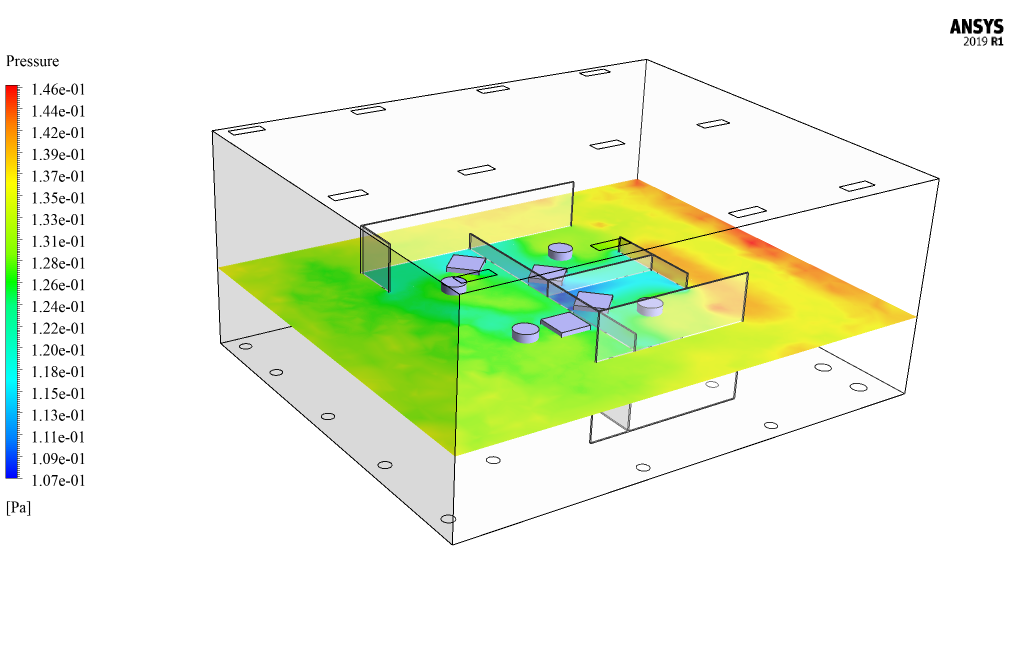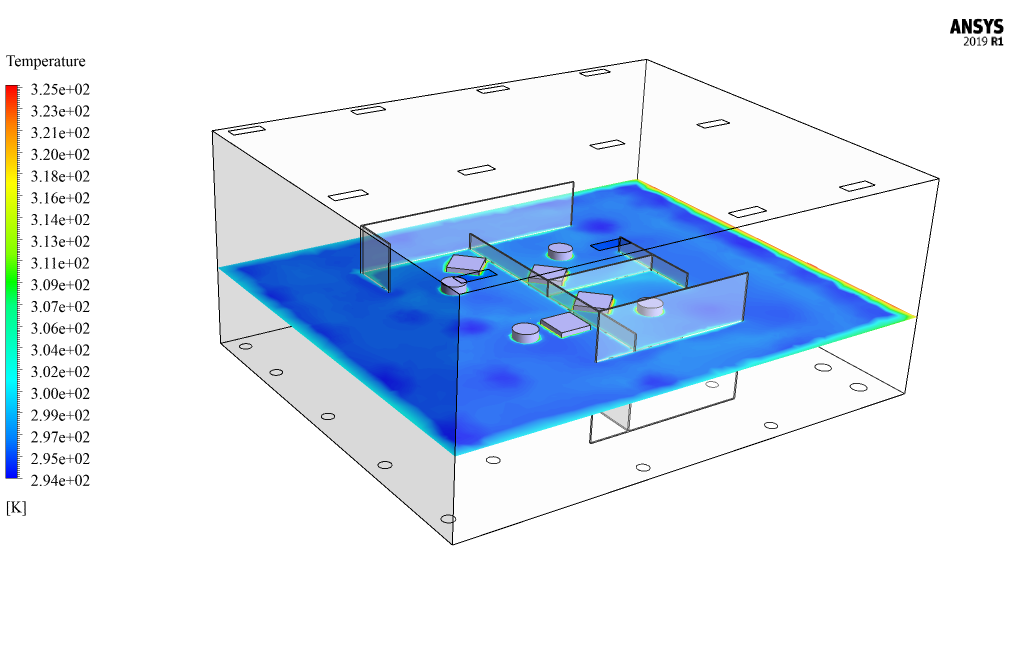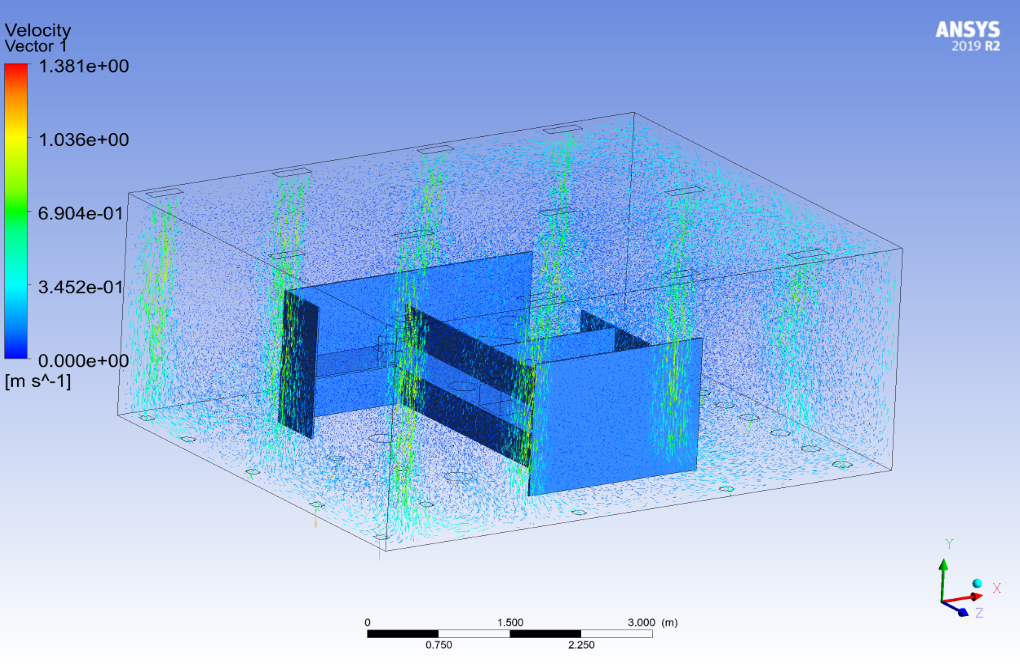Computer Room Air Conditioning CFD Simulation, DPM
$160.00 $80.00 Student Discount
- The present simulation investigates the air conditioning system of a computer room by ANSYS Fluent software
- We have designed the geometry using ANSYS Design modeler software and created the mesh on this geometry using ANSYS meshing software. The mesh type is unstructured with 3089035 cells.
- Floor Heating and Ceiling Cooling methods are applied for the HVAC. In these systems, the buoyancy effect causes free heat transfer inside the office space.
- Considering Radiation, DPM, and heat sources.
To Order Your Project or benefit from a CFD consultation, contact our experts via email (info@mr-cfd.com), online support tab, or WhatsApp at +44 7443 197273.
There are some Free Products to check our service quality.
If you want the training video in another language instead of English, ask it via info@mr-cfd.com after you buy the product.
Description
Computer Room Air Conditioning Considering Radiation and Dust Particles (DPM) ANSYS Fluent CFD Simulation Tutorial
The present problem simulates air conditioning in an office with several computers and simulators using ANSYS Fluent software. The air conditioning system in the current model is of floor heating and ceiling cooling. In these systems, the buoyancy effect causes free heat transfer inside the office space.
Due to the lightness, the hot air moves from the floor to the ceiling, and the cold air does the opposite, thus creating a circulating flow that causes the air conditioning process.
In this modeling, airflow enters the office from circular sections with a speed of 0.6125 m/s and a temperature of 291.1 K. It exits through rectangular sections on the office roof with a pressure equal to atmospheric pressure.
We design the present model in three dimensions using Design Modeler software. The model’s geometry includes an office desk measuring 6.35 m and 5.4 m at floor level and 2.7 m high. In the office, 4 computer cases and 4 simulators are located as heat sources. There are also sections such as air inlets and outlets on the floor and ceiling of the office.
We have meshed the model using ANSYS Meshing software, and the mesh type is unstructured. The element number is 3089035.
Air Conditioning Methodology
In this model, we define the Radiation model due to the radiant heat transfer between the surfaces inside the office. Also, we define particles using the DPM in inlet sections to study the behavior of airflow and the type of circulation inside the interior of the office.
Inside the office, there are 4 computer cases and 4 simulators. Due to their function, they generate a certain amount of heat and transfer it to the office’s interior. Four case devices have a heat flux boundary condition of 152.5 W/m2. Also, 4 simulators have a heat flux boundary condition of 90.56 W/m2.
Air Conditioning Conclusion
At the end of the solution process, two-dimensional and three-dimensional contours related to pressure, velocity, temperature, and three-dimensional velocity vectors are obtained. By examining these particles’ behavior and type of displacement, the flow of airflow can be analyzed.
















Mr. Ford Fisher Jr. –
Can you explain the process behind this simulation?
MR CFD Support –
Absolutely! The Cross Ventilation for Swamp Cooler Cooling simulation models the airflow and cooling effect in a room equipped with a swamp cooler. We use Design Modeler or SpaceClaim to draw the model, and ANSYS Meshing to generate high-quality elements for the simulation.
Mr. Jensen Windler –
I prepared this product, and I am completely satisfied.
Nico Willms –
Your work is exceptional! The quality of your simulations is outstanding
Donnell Conn –
I have just finished the Computer Room Air Conditioning CFD Simulation tutorial. The step-by-step instructions were clear and detailed, making it much easier to follow along with the complex analysis. Not only did I learn about air conditioning, but the incorporation of radiation and dust particles using DPM was particularly fascinating. The results gave me a good understanding of air flow circulation in an office setting. Kudos to the MR CFD team for creating such a comprehensive and educational tutorial!
MR CFD Support –
Thank you so much for your kind words! We’re delighted to know that you found the tutorial informative and easy to follow. Understanding the dynamics of air conditioning in a real office environment is crucial, and we’re glad we could help clarify these concepts. If there is anything more you’d like to learn or explore, please don’t hesitate to reach out to us.
Micaela Bechtelar –
I’m impressed with the comprehensive nature of this simulation! Are dust particles actually used to track airflow patterns throughout the office space?
MR CFD Support –
Yes, dust particles can effectively visualize the airflow’s path by detecting the particle trajectory reacting to the flow patterns and movement. This illustrative method gives a tangible understanding of circulation patterns and potential areas of recirculation or stagnant air within complex spaces like an office.
Mrs. Frida Schmitt –
I’m curious about the process behind your Computer Room CFD Simulation. Can you explain it?
MR CFD Support –
Absolutely! Our Computer Room CFD Simulation models the airflow and temperature distribution in a computer room. We use Design Modeler or SpaceClaim to draw the model, and ANSYS Meshing to generate high-quality elements for the simulation.
Brando Cremin I –
I was wondering if the DPM analysis shows where the dust particles tend to accumulate most in the computer room setup?
MR CFD Support –
In the DPM analysis, tracking the dust particles allows us to observe their trajectories and final deposition. The analysis usually reveals accumulation in regions with lower air velocities or in stagnation areas. The exact locations vary based on the airflow patterns established by the air conditioning system.
Rachelle Feest Jr. –
I have noticed that radiation is accounted for in this simulation. Does that also include the effect of heat from the monitors on the overall temperature distribution?
MR CFD Support –
Yes, radiation includes the effect of all heat-generating components within the room, which would definitely encompass the monitors, especially considering their proximity to the airflow and the simulation subjects.
Damion Osinski –
I really enjoyed the detailed analysis of the air conditioning simulation in the office with computer systems. The incorporation of floor heating alongside ceiling cooling concepts and the DPM for airflow and particle circulation is ingeniously reflective of actual workspace conditions. It’s particularly impressive how the heat sources like computer cases and simulators were implemented to mimic real heat generation. Would love to see a similar simulation for a larger office space!
MR CFD Support –
Thank you for your positive feedback! We’re glad to hear you appreciated the intricate details of our computer room air conditioning simulation, including the DPM analysis. It’s fantastic to know that the realistic approach to heat generation from the computers and simulators provided valuable insights. Your interest in a larger office space simulation has been noted. Keep an eye out for future products that may match your request!
Dr. Pattie Gerhold –
This tutorial includes radiation and DPM for the simulation. Were both these elements vital for the accuracy of this simulation, merely because they’re both complex phenomena?
MR CFD Support –
In this simulation, both radiation and Discrete Phase Model (DPM) are important to accurately simulate the heat transfer and airflow within the computer room. Radiation accounts for the thermal effects caused by equipment such as computers and simulators, and DPM helps to understand the behavior of dust particles carried by the air, which is important in maintaining a clean and functional office environment.
Lelia Hayes –
The tutorial sounds really comprehensive. Is there also data on how dust particles affect the durability and performance of the computers over time within this airflow analysis?
MR CFD Support –
I’m so glad you enjoyed the tutorial and found it comprehensive. As for the long-term effects of dust particles on the durability and performance of computers, that specific aspect isn’t covered in this simulation. The main focus here is on the airflow, temperature distribution, and dust particles’ immediate behavior. However, that’s a significant point, and it can be explored with an extended study using the deposition models and monitoring over time in the software.
Dalton Weimann III –
The product’s tutorial appears in-depth, but I am curious—how does the addition of the Radiation model and DPM affect the accuracy of the results?
MR CFD Support –
Including the Radiation model allows the simulation to account for radiant heat transfer between surfaces in the office, enhancing the realism of the results since many indoor environments experience some level of radiative heat exchange. The DPM (Discrete Phase Model) tracks dust particles and their interaction with the airflow, contributing to a more comprehensive understanding of indoor environmental quality. These additions typically improve predictive capabilities, offering a thorough analysis of thermal comfort and air quality within the conditioned space.
Prof. Sierra Bode DVM –
Is it possible to visualize the thermal comfort levels within the office based on the simulation results?
MR CFD Support –
Yes, the simulation results provide enough data to analyze and visualize thermal comfort levels. The contours related to pressure, velocity, temperature, and three-dimensional velocity vectors can be used to assess the distribution of temperature and airflow within the office, both of which are key factors in determining thermal comfort.
Prof. Tom Schuster –
Could you explain how the DPM model is integrated into the simulation to analyze the behavior of dust particles in the office air conditioning scenario?
MR CFD Support –
In the simulation, the DPM (Discrete Phase Model) is integrated to simulate and track the trajectory of dust particles as they interact with the office airflow. The dust particles are introduced at the air inlets and are carried by the airflow throughout the office, influenced by the thermal currents and ventilation system. The DPM allows us to analyze the distribution and accumulation of these particles and assess air quality as well as the efficiency of the air conditioning system in removing particulate matter.
Zelda Jakubowski –
I’m delighted with the level and detail of analysis available in the Computer Room Air Conditioning CFD Simulation offered by MR CFD. It has definitively helped me understand the environmental challenges within equipment intense rooms such as my server space. The use of DPM to model particle behavior coupled with heat transfer analyses provides insightful data to optimize our cooling strategies effectively.
MR CFD Support –
Thank you for sharing your positive experience with our Computer Room Air Conditioning CFD Simulation tutorial! We’re thrilled that it provided you with the analytical insights necessary to optimize the environmental conditions in your server room. Your satisfaction is our goal, and we hope to continue serving your CFD learning needs!
Mr. Kolby Treutel –
Enjoyed the tutorial on computer room air conditioning! The interplay of floor heating and ceiling cooling creating a fluid circulation was fascinating. Plus, exploring airflow dynamics with DPM was insightful.
MR CFD Support –
Thank you for your positive feedback on our computer room air conditioning tutorial! We’re thrilled to hear you found the simulation of the air circulation process and the use of DPM to study airflow dynamics both fascinating and insightful. Your enthusiasm for CFD learning is what motivates us to keep developing top-quality educational materials. We look forward to bringing you more useful and engaging content in the future!
Ariel Gutkowski –
I found the explanation of the heating and cooling sources particularly interesting. Can you elaborate on how the DPM model factors account into the overall air conditioning performance within the computer room? Particularly curious about the nature and impact of dust particles.
MR CFD Support –
The DPM model adds the simulation of discrete particles such as dust to the airflow dynamics. The impact of dust particles is analyzed by tracking their trajectories through the office air. This allows for understanding how dust distribution affects air quality and equipment maintenance. Also, it aids in assessing whether the air conditioning’s flow circulation is sufficient to prevent dust accumulation in critical areas where electronics are present, thus impacting overall air conditioning performance by considering particulate contaminant transport.
Rocio Cummerata –
The level of detail in your Computer Room CFD Simulation is truly impressive!
Alexandra Feeney –
The tutorial sounds comprehensive. But does it also provide recommendations for optimizing the terminal velocity of dust particles to reduce their accumulation in certain areas?
MR CFD Support –
The tutorial focuses on simulating the current air conditioning setup and understanding the behavior of dust particles. Optimization for reducing dust particle accumulation is not covered within its scope, but further simulations and analysis can be carried out for such purposes.
Audra Spencer –
Can you explain how the DPM model impacts the study of airflow circulation in the office environment in comparison to scenarios without considering dust particles?
MR CFD Support –
In this simulation, the Discrete Phase Model (DPM) accounts for the dust particles’ potential impact on the air circulation within the office. By including these particles, the model provides insights into how contamination or particle distribution behaves due to airflow dynamics, providing a more comprehensive analysis of indoor air quality and maintaining a healthier environment than scenarios only considering clean air without particles.
Breana Langworth Sr. –
This tutorial was a lifesaver! My own office has some intricate airflow issues, and seeing the detailed setup and results for the computer room air conditioning simulation gave me tons of insights. The DPM model in particular was incredibly well-explained. Thank you!
MR CFD Support –
Thank you so much for your kind words! We’re delighted to hear that our Computer Room Air Conditioning tutorial was helpful in addressing the airflow issues in your office. It’s great that the Dust Particles (DPM) model provided you with the clarity needed to understand air circulation better. Your feedback is much appreciated!
Anabelle Huels –
Could you explain more about how the Dust Particle Model (DPM) is used to analyze airflow in this computer room setup?
MR CFD Support –
Certainly! In the simulation, the Discrete Phase Model (DPM) is used to track the movement and behavior of dust particles as air circulates through the computer room. It helps visualize the circulation patterns and areas where dust might accumulate due to the flow characteristics. This model accounts for the interaction between the particles and the airflow, as well as any potential impacts on heat transfer and air quality within the room.
Ariane Lowe –
The content is thorough and insightful. Having both temperature control and particle analysis in the simulation provides a comprehensive view of air conditioning efficiency. Great job on addressing radiation and DPM in a practical environment!
MR CFD Support –
Thank you for your positive review! We are glad you appreciated the details and comprehensiveness of the Computer Room Air Conditioning simulation tutorial using ANSYS Fluent. Your feedback is valuable to us, and we look forward to providing you with more high-quality learning materials in the future!
Javier Kuhn –
What specific methods did you use to model dust particle behavior within the office airflow?
MR CFD Support –
In this CFD simulation, the behavior of dust particles in the office airflow is modeled using the Discrete Phase Model (DPM) in ANSYS Fluent. This enables tracking and analysis of individual particles through the air, providing insights into how dust circulates and settles within the air conditioned space.